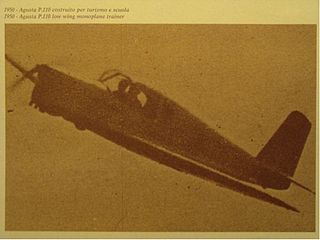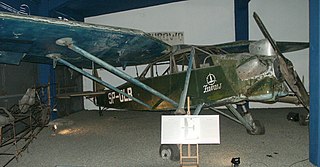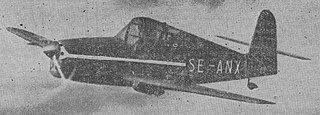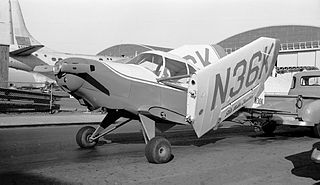Related Research Articles

The Aero-Flight Streak was an American two-seat light aircraft built in 1946 by Aero-Flight Aircraft Corporation at Buffalo, New York. Advanced for its time, it was of all-metal construction with tricycle undercarriage, and accommodated the pilot and passenger in tandem beneath a sliding, bubble canopy.

The Auster J/2 Arrow is a 1940s British single-engined two-seat high-wing touring monoplane built by Auster Aircraft Limited at Rearsby, Leicestershire, England.

The Agusta CP-110, also known as CVV P.110 or Politecnico P.110, was a prototype Italian four-seat light aircraft first flown in 1951 that failed to attract interest from either civil or military operators, although it was evaluated by the Aeronautica Militare. Originally designed and built by the CVV -, production aircraft were to have been built by Agusta, but for lack of interest.

The All American 10A Ensign was a two-seat light plane built in the United States shortly after World War II. It was a low-wing, all-metal cantilever monoplane with fixed tricycle undercarriage and which seated its pilot and passenger side by side under an expansive bubble canopy. Due to the glut of military surplus aircraft on the civil market after the war, All American was unable to attract buyers and no production ensued.
The Breda-Pittoni B.P.471 was an Italian twin-engine airliner/military transport produced by Breda.

The Call-Air Model A is an American two- to three-seat utility aircraft designed by the Call brothers and built by the Call Aircraft Company, later developed into a successful line of agricultural aircraft.
The Brochet MB.120 was a two-seat light aircraft developed in France in the 1950s.
The CAP-1 Planalto was a military trainer aircraft built in Brazil during World War II. It was a low-wing cantilever monoplane with fixed tailwheel undercarriage that accommodated the pilot and instructor in tandem open cockpits. The project had been initiated by Instituto de Pesquisas Tecnológicas (IPT) under the designation IPT-4 and although the design work had been contracted to CAP, IPT insisted on a wing profile of its own choosing that led to serious stability problems in the final product.

The Funk Model B was a 1930s American two-seat cabin monoplane designed by Howard and Joe Funk. Originally built by the Akron Aircraft Company later renamed Funk Aircraft Company.
The Fletcher FL-23 was an American two-seat liaison or observation aircraft designed and built by the California-based Fletcher Aviation Corporation. It was entered into a competition and lost against the Cessna 305A as a liaison or observation aircraft for the United States Army.

The SIAI-Marchetti SM.102 was a 1940s Italian light transport cabin monoplane designed and built by SIAI-Marchetti.

The Macchi MB.308, later Aermacchi MB-308, was a light aircraft produced in Italy in the late 1940s.

The LWD Żuraw was a Polish utility and liaison aircraft prototype of 1951, high-wing monoplane with single engine, that did not enter production. The name means crane.

The MDG Midgy-Club was a post-war cabin biplane designed and built by Instruments de Precision M.D.G at Garches, France. The company designed and built precision instruments and due to the close relationship with the aviation industry, the company designed and built two aircraft. The first, MDG LD.45, was a single-seat biplane. The MDG LD-261 Midgy-Club was a follow-on design with an enclosed cabin with two seats arranged in tandem layout. It was built in small numbers.
The THK-2 was a single-seat, single-engine aerobatic trainer aircraft developed in Turkey in 1944 intended as an advanced trainer. It was a conventional, low-wing cantilever monoplane with an elliptical planform and of wooden construction. The cockpit was enclosed and the main units of the tailwheel undercarriage retracted backwards into the wing.

The Ambrosini Rondone is an Italian-designed two/three-seat light touring monoplane of the early 1950s.
The Aeronca 12AC Chum was a 2-seat cabin monoplane designed and produced by Aeronca in the United States in 1946. The design was a licence-built version of the ERCO Ercoupe.

The Skandinaviska Aero BHT-1 Beauty is a 1940s Swedish single-seat light monoplane designed by E. Bratt, K.E. Hilfing and B.Törnblom and built by Skandinaviska Aero of Stockholm.
The Viberti Musca 1 is a 1940s Italian two-seat civil touring monoplane produced by Ali Verberti SpA of Turin.

The Stits-Besler Executive is a three place homebuilt aircraft designed by Ray Stits, as the Stits SA-4A Executive.
References
Citations
- ↑ Bridgman 1951, p. 150c.
Bibliography
- Bridgman, Leonard (1951). Jane's All The World's Aircraft 1951–52. London: Sampson Low, Marston & Company, Ltd.
- "Aerauto PL.5C" . Retrieved 18 February 2016.